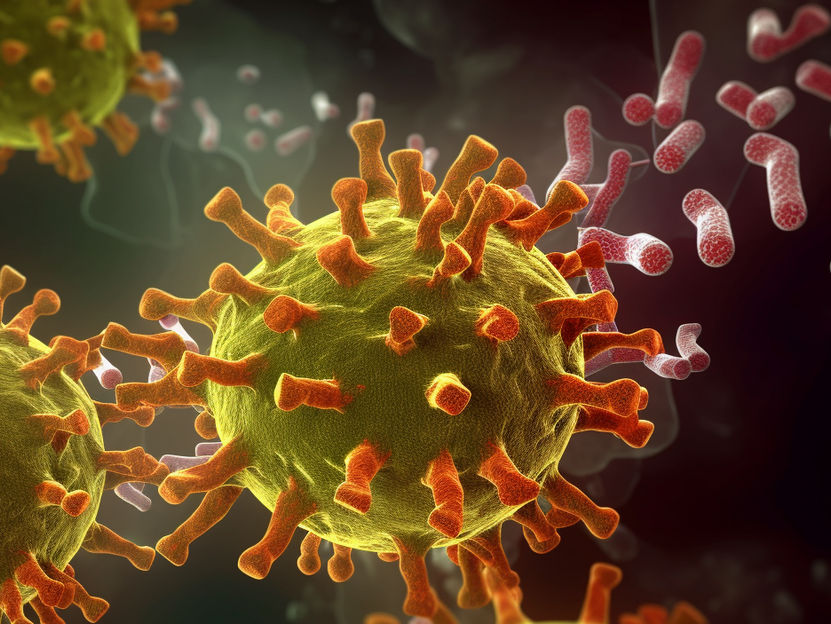Bacterial weapons against viral diseases
Discovery of two novel classes of natural products with activity against RNA viruses
Advertisement
The Covid-19 pandemic has dramatically demonstrated that the development of effective agents against viral pathogens is of great importance for global health. Although effective vaccines are available for many viral diseases, there is an urgent need for new and effective therapeutic treatments. At the Helmholtz Institute for Pharmaceutical Research Saarland (HIPS), the team led by Prof Rolf Müller is researching novel active substances for the treatment of infections. In their latest studies, the researchers were able to identify two new natural product families with promising activity against viruses. Their results have now been published in the journal Angewandte Chemie International Edition.

Symbolic image
Computer-generated image
The COVID-19 pandemic caused by SARS-CoV-2 has challenged healthcare systems around the world in an unprecedented way. The rapid global spread of this pathogen, combined with sometimes severe disease progression, shows how urgently effective drugs are needed to treat viral diseases. However, SARS-CoV-2 is by far not the only human pathogenic RNA virus with high economic and social relevance. Therefore, especially in view of possible viral pandemics of the future, the identification of new agents with broad efficacy against emerging viral pathogens is of utmost importance. Rolf Müller's team at HIPS has been successfully researching antibacterial natural products isolated from soil bacteria for many years. In particular, actinobacteria, which have already been studied for decades, and myxobacteria, which have only been researched to a much lesser extent, are valuable sources for new natural products. HIPS is a site of the Helmholtz Centre for Infection Research (HZI) in cooperation with Saarland University.
The researchers have now succeeded in isolating two new families of active substances with antiviral activity from the adept natural product producers: the persicamidines and the thiamyxines. While the persicamidines were isolated from a newly discovered strain of actinobacteria, the thiamyxins originate from a strain of myxobacteria found by HIPS scientists in the immediate vicinity of the institute. Within the scope of the citizen science project "The Microbial Treasure Chest", the strain collection of HIPS could already be extended by about 1000 new myxobacteria, which were isolated from more than 700 soil samples sent in so far.
Both of the abovementioned bacterial families are known natural product producers, especially for antibiotics. In the studies now published, the scientists at HIPS, in collaboration with the virus specialists in the research groups of Prof Thomas Pietschmann at TWINCORE and Prof Ralf Bartenschlager at DKFZ, are using their profound experience and expertise in the field of antibiotics research to isolate the new natural products and investigate them in greater detail with regard to their antiviral activity.
Both natural product families show structural peculiarities, which in the case of the persicamidines required extensive structural analyses. For the thiamyxins, it was even possible to describe a biosynthetic model by means of so-called feeding experiments with specially labeled precursors. For both newly discovered natural product families, the scientists were able to demonstrate strong inhibition of RNA viruses in Corona-, Zika- and dengue virus infection models. In the case of persicamidines, activities against SARS-CoV-2 and hCoV-229E are even roughly comparable to the conditionally approved drug remdesivir, which is used to treat COVID-19.
"The problem of antimicrobial resistance and the search for new antibiotics are the core of our research. However, the COVID-19 pandemic has been a powerful reminder of how important the development of antiviral agents is as well. Therefore, in the future, we intend to use our expertise to develop compounds against both bacterial and viral infections. In the case of persicamidines, we see that the starting point for solving global problems may even be right on our doorstep," says Rolf Müller, Managing Director of HIPS, Head of the Department Microbial Natural Products and Coordinator of the Research Area Novel Antibiotics at the German Center for Infection Research (DZIF).
Due to their good antiviral activities, the new natural product classes represent promising starting points for the development of future active agents against SARS-CoV-2 and other RNA viruses. Biotechnological optimization of the production or the development of a chemical synthesis route are now of great interest due to the comparatively low production rates of the thiamyxins in order to make the natural product available in sufficient quantities for further analyses. In follow-up studies, the researchers intend to investigate the mode-of-action of the two new natural product families, the elucidation of which will be a further step towards the development of antiviral agents.
Original publication
Haack, P.A., Harmrolfs, K., Bader, C.D., Garcia, R., Gunesch, A.P., Haid, S., Popoff, A., Voltz, A., Kim, H., Bartenschlager, R., Pietschmann, T., and Müller, R.* (2022) Thiamyxins: Structure and Biosynthesis of Myxobacterial RNA-Virus Inhibitors, Angew. Chem. Int. Ed., e202212946
Keller, L., Oueis, E., Kaur, A., Safaei, N., Kirsch, S.H., Gunesch, A.P., Haid, S., Rand, U., Čičin-Šain, L., Fu, C., Wink, J., Pietschmann, T., and Müller, R.* (2023) Persicamidines—Unprecedented Sesquarterpenoids with Potent Antiviral Bioactivity against Coronaviruses, Angew. Chem. Int. Ed., e202214595























































